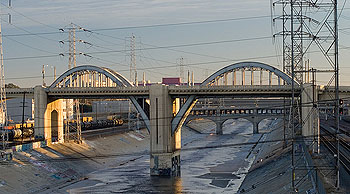 The 6th Street Viaduct in Los Angeles has been slowly crumbling for years thanks to defects in the cement originally used to build it, and the city recently unveiled its plans for a replacement:
The 6th Street Viaduct in Los Angeles has been slowly crumbling for years thanks to defects in the cement originally used to build it, and the city recently unveiled its plans for a replacement:
After a series of public meetings over the last two years, city engineers decided that replacing the bridge was the only viable option….A model of the proposed span shows two rectangular towers in the middle of the bridge, with cables down both sides.
….The cost of replacing the viaduct with the proposed structure is estimated to be about $345 million, officials said.
This is just idle musing, but I wonder why this bridge costs so much? The original structure cost $2.3 million, which comes to about $36 million in today’s dollars. In real terms, then, the bridge costs ten times as much today as it did in 1932.
Why? Labor costs are proportionately higher today, of course. The old bridge has to be built around and then demolished. LA is built up and we can’t just build a cement factory on site, the way we did 75 years ago. Earthquake standards and general permitting requirements are more stringent.
On the other hand, we also have 75 years of technology progression. Labor costs may be higher, but we use less total labor and more machinery these days. And computers help with most of the design work.
Like I said, just idle musing. But it sure seems odd that after 75 years of fantastic technological progress, it not only costs more to build a bridge than it used to, but it costs ten times more. That’s a lot of dough. I just hope it’s shovel ready.

















